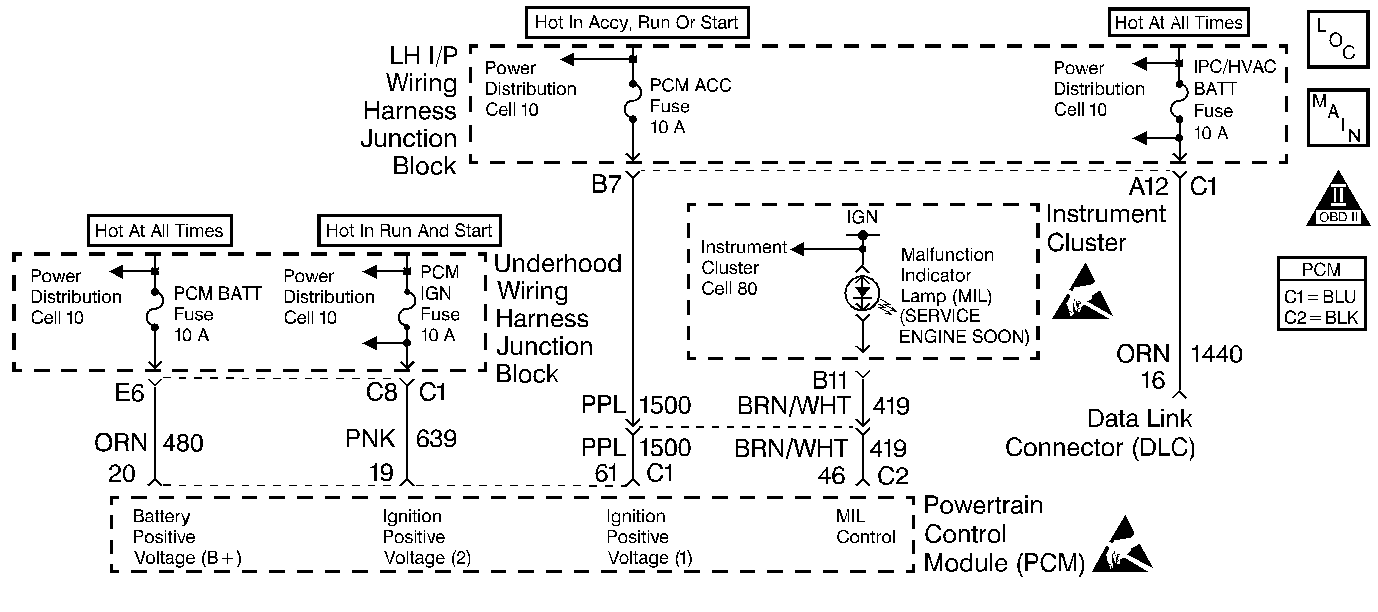
Circuit Description
The Powertrain Control Module (PCM) monitors the ignition voltage on the ignition positive voltage #2 circuit to the PCM. A system voltage DTC will set whenever the voltage is above or below a calibrated value.
Conditions for Setting the DTC
| • | The engine speed is greater than 1300 RPM. |
| • | The ignition voltage is less than 10 volts for 240 seconds. |
Action Taken When the DTC Sets
| • | The PCM will record the operating conditions at the time during which the diagnostic fails. This information will store in the Failure Records buffer. |
| • | A history DTC stores. |
| • | The coolant fan turns ON. |
Conditions for Clearing the MIL/DTC
| • | A history DTC will clear after 40 consecutive warm up cycles without a fault. |
| • | A scan tool can clear the MIL/DTCs. |
Diagnostic Aids
| • | If the DTC sets when you operate an accessory, check for a poor electrical connection or an excessive current draw. |
| • | Thoroughly check any suspected circuitry for the following conditions: |
| - | Backed out terminals |
| - | Improper mating |
| - | Broken locks |
| - | Improperly formed connectors |
| - | Damaged terminals |
| - | Poor terminal to wiring connections |
| - | Physical damage to the wiring harness |
Test Description
The number(s) below refer(s) to the step number(s) on the Diagnostic Table.
-
The Powertrain OBD System Check prompts you to complete some of the basic checks and to store the freeze frame and failure records data on the scan tool if applicable. This creates an electronic copy of the data captured when this DTC set. The scan tool stores this data for later reference.
-
This step checks if the generator is malfunctioning under load conditions.
-
The PCM Controlled Generator Diagnosis will further check the PCM's control of the generator.
-
This step checks the ignition positive voltage circuit #2 for any excessive resistance. An open circuit will cause a no start condition.
-
Reprogram the replacement PCM and perform the crankshaft position system variation learning procedure. Refer to the latest Techline procedures for PCM reprogramming and the Powertrain Control Module (PCM) for the crankshaft position system variation learning procedure.
-
If no malfunctions are present at this point and no additional DTCs were set, refer to Diagnostic Aids for additional checks and information.
Step | Action | Value(s) | Yes | No |
|---|---|---|---|---|
Did you perform the Powertrain On-Board Diagnostic (OBD) System Check? | -- | |||
Is the ignition voltage less than the specified value? | 1400 RPM 10 V | |||
Is the battery voltage greater than the specified value? | 1400 RPM 12 V | Go to Powertrain Control Module Controlled Generator Diagnosis | ||
Is the ignition voltage greater than the specified value? | 10 V | |||
5 | Check for a malfunctioning terminal connection at the PCM and repair the connection as necessary. Was a repair necessary? | -- | ||
6 | Repair the poor electrical connection (high resistance) in the ignition positive voltage circuit #2. Is the action complete? | -- | -- | |
Replace the PCM. Is the action complete? | -- | -- | ||
8 |
Does the scan tool indicate that this diagnostic has ran and passed? | -- | ||
Check to see if any DTCs are set. Does the scan tool display any DTCs that you have not diagnosed? | -- | Go to applicable DTC table | System OK Refer to Diagnostic Aids |
